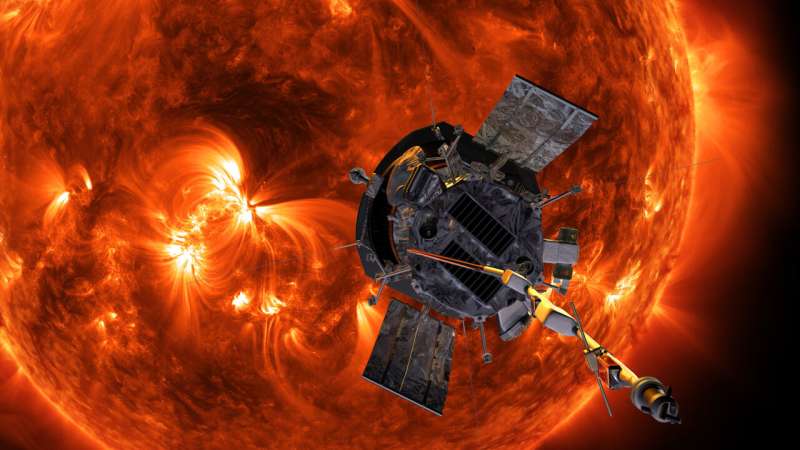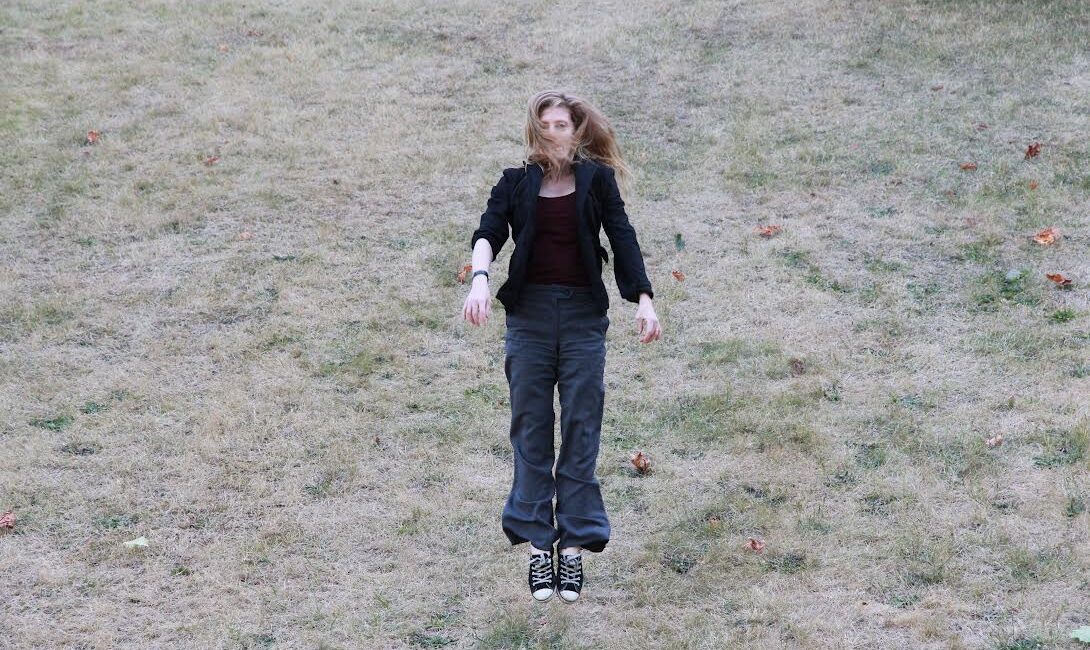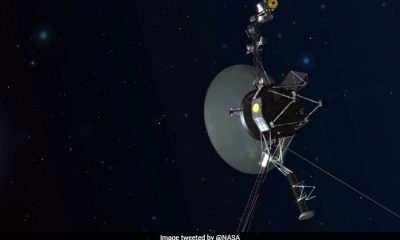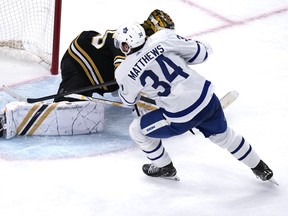Science
Parker Solar Probe flies into the fast solar wind and finds its source

|
|
NASA’s Parker Solar Probe (PSP) has flown close enough to the sun to detect the fine structure of the solar wind close to where it is generated at the sun’s surface, revealing details that are lost as the wind exits the corona as a uniform blast of charged particles.
It’s like seeing jets of water emanating from a showerhead through the blast of water hitting you in the face.
In a paper to be published in the journal Nature, a team of scientists led by Stuart D. Bale, a professor of physics at the University of California, Berkeley, and James Drake of the University of Maryland-College Park, report that PSP has detected streams of high-energy particles that match the supergranulation flows within coronal holes, which suggests that these are the regions where the so-called “fast” solar wind originates.
Coronal holes are areas where magnetic field lines emerge from the surface without looping back inward, thus forming open field lines that expand outward and fill most of space around the sun. These holes are usually at the poles during the sun’s quiet periods, so the fast solar wind they generate doesn’t hit Earth. But when the sun becomes active every 11 years as its magnetic field flips, these holes appear all over the surface, generating bursts of solar wind aimed directly at Earth.
Understanding how and where the solar wind originates will help predict solar storms that, while producing beautiful auroras on Earth, can also wreak havoc with satellites and the electrical grid.
“Winds carry lots of information from the sun to Earth, so understanding the mechanism behind the sun’s wind is important for practical reasons on Earth,” Drake said. “That’s going to affect our ability to understand how the sun releases energy and drives geomagnetic storms, which are a threat to our communication networks.”
Based on the team’s analysis, the coronal holes are like showerheads, with roughly evenly spaced jets emerging from bright spots where magnetic field lines funnel into and out of the surface of the sun. The scientists argue that when oppositely directed magnetic fields pass one another in these funnels, which can be 18,000 miles across, the fields often break and reconnect, slinging charged particles out of the sun.
“The photosphere is covered by convection cells, like in a boiling pot of water, and the larger scale convection flow is called supergranulation,” Bale said. “Where these supergranulation cells meet and go downward, they drag the magnetic field in their path into this downward kind of funnel. The magnetic field becomes very intensified there because it’s just jammed. It’s kind of a scoop of magnetic field going down into a drain. And the spatial separation of those little drains, those funnels, is what we’re seeing now with solar probe data.”
Based on the presence of some extremely high-energy particles that PSP has detected—particles traveling 10 to 100 times faster than the solar wind average—the researchers conclude that the wind could only be made by this process, which is called magnetic reconnection. The PSP was launched in 2018 primarily to resolve two conflicting explanations for the origin of the high-energy particles that comprise the solar wind: magnetic reconnection or acceleration by plasma or Alfvén waves.
“The big conclusion is that it’s magnetic reconnection within these funnel structures that’s providing the energy source of the fast solar wind,” Bale said. “It doesn’t just come from everywhere in a coronal hole, it’s substructured within coronal holes to these supergranulation cells. It comes from these little bundles of magnetic energy that are associated with the convection flows. Our results, we think, are strong evidence that it’s reconnection that’s doing that.”
The funnel structures likely correspond to the bright jetlets that can be seen from Earth within coronal holes, as reported recently by Nour Raouafi, a co-author of the study and the Parker Solar Probe project scientist at the Applied Physics Laboratory at Johns Hopkins University. APL designed, built, manages and operates the spacecraft.
Plunging into the sun
By the time the solar wind reaches Earth, 93 million miles from the sun, it has evolved into a homogeneous, turbulent flow of roiling magnetic fields intertwined with charged particles that interact with Earth’s own magnetic field and dump electrical energy into the upper atmosphere. This excites atoms, producing colorful auroras at the poles, but has effects that trickle down into Earth’s atmosphere. Predicting the most intense winds, called solar storms, and their near-Earth consequences is one mission of NASA’s Living With a Star program.
The probe was designed to determine what this turbulent wind looks like where it’s generated near the sun’s surface, or photosphere, and how the wind’s charged particles—protons, electrons and heavier ions, primarily helium nuclei—are accelerated to escape the sun’s gravity.
To do this, PSP had to get closer than 25 to 30 solar radii, that is, closer than about 13 million miles.
“Once you get below that altitude, 25 or 30 solar radii or so, there’s a lot less evolution of the solar wind, and it’s more structured—you see more of the imprints of what was on the sun,” Bale said.
In 2021, PSP’s instruments recorded magnetic field switchbacks in the Alfvén waves that seemed to be associated with the regions where the solar wind is generated. By the time the probe reached about 12 solar radii from the surface of the sun—5.2 million miles—the data were clear that the probe was passing through jets of material, rather than mere turbulence. Bale, Drake and their colleagues traced these jets back to the supergranulation cells in the photosphere, where magnetic fields bunch up and funnel into the sun.
But were the charged particles being accelerated in these funnels by magnetic reconnection, which would slingshot particles outward, or by waves of hot plasma—ionized particles and magnetic field—streaming out of the sun, as if they’re surfing a wave?
The fact that PSP detected extremely high-energy particles in these jets—tens to hundreds of kiloelectron volts (keV), versus a few keV for most solar wind particles—told Bale that it has to be magnetic reconnection that accelerates the particles and generates the Alfvén waves, which likely give the particles an extra boost.
“Our interpretation is that these jets of reconnection outflow excite Alfvén waves as they propagate out,” Bale said. “That’s an observation that’s well known from Earth’s magnetotail, as well, where you have similar kind of processes. I don’t understand how wave damping can produce these hot particles up to hundreds of keV, whereas it comes naturally out of the reconnection process. And we see it in our simulations, too. ”
The PSP won’t be able to get any closer to the sun than about 8.8 solar radii above the surface—about 4 million miles—without frying its instruments. Bale expects to solidify the team’s conclusions with data from that altitude, though the sun is now entering solar maximum, when activity becomes much more chaotic and may obscure the processes the scientists are trying to view.
“There was some consternation at the beginning of the solar probe mission that we’re going to launch this thing right into the quietest, most dull part of the solar cycle,” Bale said. “But I think without that, we would never have understood this. It would have been just too messy. I think we’re lucky that we launched it in the solar minimum.”
More information:
Stuart Bale, Interchange reconnection as the source of the fast solar wind within coronal holes, Nature (2023). DOI: 10.1038/s41586-023-05955-3. www.nature.com/articles/s41586-023-05955-3
Provided by
University of California – Berkeley
Citation:
Parker Solar Probe flies into the fast solar wind and finds its source (2023, June 7)
retrieved 8 June 2023
from https://phys.org/news/2023-06-parker-solar-probe-flies-fast.html
This document is subject to copyright. Apart from any fair dealing for the purpose of private study or research, no
part may be reproduced without the written permission. The content is provided for information purposes only.





Science
NASA hears from Voyager 1, the most distant spacecraft from Earth, after months of quiet
|
|
CAPE CANAVERAL, Fla. (AP) – NASA has finally heard back from Voyager 1 again in a way that makes sense.
The most distant spacecraft from Earth stopped sending back understandable data last November. Flight controllers traced the blank communication to a bad computer chip and rearranged the spacecraft’s coding to work around the trouble.
NASA’s Jet Propulsion Laboratory in Southern California declared success after receiving good engineering updates late last week. The team is still working to restore transmission of the science data.
It takes 22 1/2 hours to send a signal to Voyager 1, more than 15 billion miles (24 billion kilometers) away in interstellar space. The signal travel time is double that for a round trip.
Contact was never lost, rather it was like making a phone call where you can’t hear the person on the other end, a JPL spokeswoman said Tuesday.
Launched in 1977 to study Jupiter and Saturn, Voyager 1 has been exploring interstellar space – the space between star systems – since 2012. Its twin, Voyager 2, is 12.6 billion miles (20 billion kilometers) away and still working fine.





Science
SpaceX launches 23 Starlink satellites from Florida (photos)


|
|
SpaceX sent yet another batch of its Starlink internet satellites skyward today (April 23).
A Falcon 9 rocket topped with 23 Starlink spacecraft lifted off from Florida’s Cape Canaveral Space Force Station today at 6:17 p.m. EDT (2217 GMT).
The Falcon 9’s first stage came back to Earth for a vertical landing about 8.5 minutes after launch as planned. It touched down on the SpaceX droneship Just Read the Instructions, which was stationed in the Atlantic Ocean.
It was the ninth launch and landing for this particular booster, according to a SpaceX mission description. Five of its previous eight liftoffs were Starlink missions.
The Falcon 9’s upper stage will continue carrying the 23 Starlink satellites toward low Earth orbit (LEO) today, deploying them about 65 minutes after liftoff.
This evening’s launch was the 41st of the year for SpaceX, and the 28th of 2024 dedicated to building out the huge and ever-growing Starlink megaconstellation. There are nearly 5,800 operational Starlink satellites in LEO at the moment, according to astrophysicist and satellite tracker Jonathan McDowell.
The Starlink launch ended up being the first half of a spaceflight doubleheader: A Rocket Lab Electron vehicle launched two satellites, including a NASA solar-sailing technology demonstrator, from New Zealand today at 6:33 p.m. EDT (2233 GMT).
Editor’s note: This story was updated at 6:30 p.m. ET on April 23 with news of successful launch and first-stage landing.





Science
Exploring ecological networks in a digital world | News | Vancouver Island University | Canada – Vancouver Island University News


Getting to know Samantha Letourneau
By day, Samantha Letourneau is Vancouver Island University’s Canada Learning Bond project lead and Volunteer Tutor Coordinator. She’s also a musician and dancer and for the past two years, she’s been collaborating with Swedish artist Mårten Spångberg, thanks to funding obtained through Crimson Coast Dance, to create a digital art installation that goes live on Friday, April 26. A launch event takes place at Black Rabbit restaurant in the Old City Quarter that night. Samantha is also hosting a creative process workshop on April 27 and 28.
Can you share a bit about your background as an artist and how you got into it?
I have been working in art for a very long time, as a musician and dancer as well as an art administrator and program coordinator. I started music at the age of 11 and dance came later in my life in my early 20s. I always wanted to do dance, but I grew up in a small community in Yellowknife and at that time the only dance classes available were highland dancing, which I was not very interested in.
In my early 20s while living in Vancouver, I took classes in contemporary dance and was fortunate to land a small part in the Karen Jameison Dance company for a piece called The River. The River was about rivers and connection between the reality of a real and physical outdoor river and the different reality of “the river within.” It was both a piece of art and outreach for the community. It included working with the S’pak’wus Slu’lum Dancers of the Squamish Nation. Somewhat ground-breaking for 1998.
From there I was hooked and wanted to do more in dance. I studied a lot and took many classes. Fast forward to now, I have been involved with productions and performances with Crimson Coast Dance for more than 15 years and greatly appreciate the talent and innovation that Artistic Director Holly Bright has brought to this community. She is amazing and very supportive of artists in Nanaimo.
How did this international exchange come about?
The Nordic/Nanaimo exchange is one of the innovative projects Holly created. At the height of the pandemic, funded by BC Arts Council and Made In BC, Crimson Coast Dance embarked on a project that explored the ways in which Nanaimo artists could participate in online exchanges.
Two artists in Nanaimo – myself and Genevieve Johnson – were introduced to artists from Europe and supported through this international exchange. My collaborator, Mårten Spångberg, is a Swedish artist living and working in Berlin. An extension of that exchange is funded by Canada Council for the Arts – Digital Now.
What brought Mårten and myself together – and I quote Mårten here – is “questions around climate change, ecology and the influence contemporary society has on its environments. We are not interested in making art about the ecological crises or informing our audience about the urgency that climate change implies, but instead through our research develop work that in itself proposes, practices and engages in alternative ecologies.”
We share an understanding that art is a unique place, in the sense of practice, activation, performance and event, through which alternative ecologies can emerge and be probed and analyzed.
Tell us about the launch event.
We are launching the digital art installation that Mårten and I created on April 26 at The Attic at Black Rabbit Restaurant. The event is free to attend but people must sign up as seating is limited. I produced video art with soundscapes that I recorded mixing field recordings with voice and instrumentation. Marten explores text, imagery and AI.
My focus is on the evolving and ongoing process of how we communicate with each other and to nature within a digital context.
During our collaboration, Mårten and I talked about networks, though not just the expansive digital network of the internet but of nature. We shared thoughts on mycelium, a network of fungal threads or hyphae, that lately has received much attention on the importance of its function for the environment, including human beings.
Building off this concept, ideas of digital and ecological landscapes being connected emerged. From this we worked both collaboratively and individually to produce material for this digital project. Mårten will be there via Zoom as well and we will talk about this two-year process and the work we created together.
-



 Health2 hours ago
Health2 hours agoRemnants of bird flu virus found in pasteurized milk, FDA says
-
Art8 hours ago
Mayor's youth advisory council seeks submissions for art gala – SooToday
-



 Science16 hours ago
Science16 hours ago"Hi, It's Me": NASA's Voyager 1 Phones Home From 15 Billion Miles Away – NDTV
-
Art20 hours ago
Made Right Here: Woodworking art – CTV News Kitchener
-
News14 hours ago
Some Canadians will be digging out of 25+ cm of snow by Friday – The Weather Network
-
Real eState19 hours ago
Caution about Canada's private real estate sector abounds as valuations slow to adjust – The Globe and Mail
-



 Sports17 hours ago
Sports17 hours agoAuston Matthews turns it up with three-point night as Maple Leafs slay Bruins in Game 2 – Toronto Sun
-
Media13 hours ago
Jon Stewart Slams the Media for Coverage of Trump Trial – The New York Times





